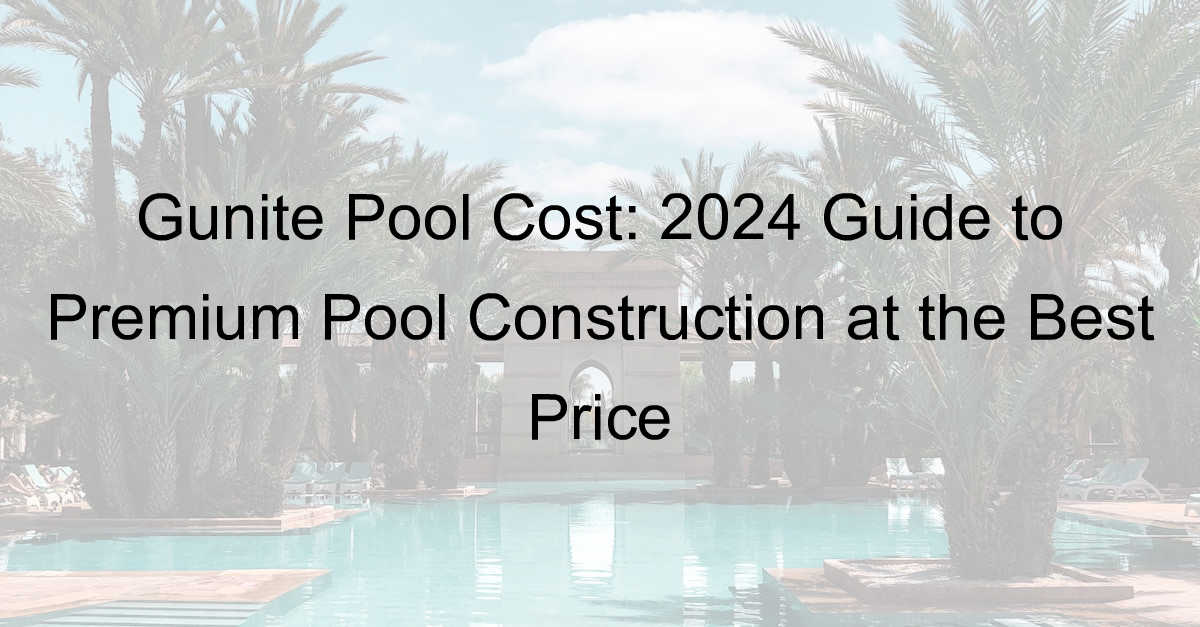Table of Contents
Building a pool is a significant investment, yet it offers endless joy and relaxation for your family. In 2024, gunite pool cost is an essential factor to consider for premium construction. Understanding the nuances of both pricing and quality will help you make informed decisions. This guide aims to provide valuable insights while ensuring you get the best value for your dream pool.
Main Points
- Understanding the basics of gunite pool construction.
- Factors influencing gunite pool cost.
- Tips for maximizing your investment.
Understanding the Factors Influencing Gunite Pool Costs in 2024
When contemplating the installation of a gunite pool, numerous factors can significantly influence the overall cost. As 2024 approaches, homeowners face decisions that extend beyond just aesthetic preferences.
Key Factors to Consider
- Size and Depth: The dimensions of the pool will largely dictate material and labor expenses. A larger pool typically means higher costs.
- Location: The geographical area can affect both the price of materials and the availability of skilled labor. Urban areas often have more competitive pricing.
- Customization: Unique features such as water features or lighting can enhance the charm but at an added cost.
Nonetheless, challenges can arise. For instance, unexpected site conditions might lead to higher excavation costs. Moreover, fluctuations in supply chain dynamics can create inconsistencies in material prices. Therefore, it is prudent to obtain multiple quotes and consider your long-term vision for the space. Every detail matters, and with adequate research and proper planning, your dream pool can become a reality without breaking the bank.
Maximizing Value: Tips for Budget-Friendly Gunite Pool Construction
Building a gunite pool doesn’t have to break the bank. With careful planning and a few strategic choices, you can achieve a stunning addition to your home without overspending. First, consider the size and shape of your pool. A straightforward rectangular design often costs less than intricate shapes, which might surprise some. However, simplicity can be elegant.
Next, look into construction materials. While gunite has its advantages, blending with other materials, like plaster or tile, can reduce costs significantly. Don’t overlook the importance of timing. If possible, schedule your project in the off-season. This can save you money on labor and materials, creating a win-win situation.
Budget Breakdown
| Expense | Estimated Cost |
|---|---|
| Design and Planning | $1,000 |
| Materials | $10,000 |
| Labor | $5,000 |
In conclusion, options abound in gunite pool construction. Prioritize what matters most, while remaining adaptable. Keep your vision clear, and your budget intact.
Conclusion
In conclusion, exploring the topic of undefined aspects in our lives allows us to reflect on what truly matters. We all face uncertainties, whether it’s in relationships, career paths, or personal aspirations. Understanding these undefined areas can be freeing, as they encourage us to embrace change and growth. By tackling these uncertainties, we become more resilient and empowered. Additionally, when it comes to investments like a gunite pool, knowing the costs involved can help us make informed decisions about our future. Ultimately, navigating the unknown can lead to exciting opportunities and deeper connections with ourselves and others. So, let’s not shy away from the undefined; instead, let’s embrace it and learn from it as we move forward.
Frequently Asked Questions
What is the average cost of a gunite pool?
The average cost of a gunite pool typically ranges from $30,000 to $70,000, depending on factors like size, location, and additional features.
How long does it take to install a gunite pool?
The installation of a gunite pool usually takes about 3 to 6 months, depending on weather conditions and the complexity of the design.
What maintenance is required for a gunite pool?
Gunite pools require regular maintenance including cleaning, balancing chemicals, and periodic resurfacing, typically every 10 to 15 years, to maintain their appearance and function.
